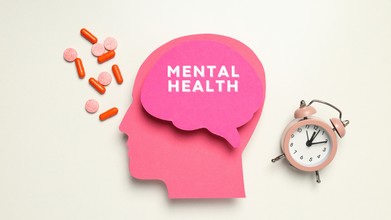- Health Conditions A-Z
- Health & Wellness
- Nutrition
- Fitness
- Health News
- Ayurveda
- Videos
- Medicine A-Z
- Parenting
- Web Stories
Miriam Margolyes, Harry Potter Star Shares Honest Health Update 'I've Let My Body Down'

(Credit-Miriam Margoyle/Wizarding World)
Actress Miriam Margolyes, known for her role as Professor Sprout in the Harry Potter films, recently spoke openly about her health issues. In a new interview, the 84-year-old admitted her lifestyle has taken a toll on her body, which she links to a lifelong struggle with her weight.
When asked about using Ozempic for weight loss, Margolyes firmly rejected the idea, stating, "That’s for diabetics. You shouldn’t take medicine meant for people who are really sick."
Her health struggles have also led to her considering her own mortality. After a recent heart procedure, she shared that she knows she "doesn’t have long left to live," likely within the next five to six years. Despite this, she expressed a strong desire to continue performing, even though she isn't "strong enough" for roles that don't involve a wheelchair.
Miriam Margolyes Health
In May 2023, Margolyes was hospitalized with a chest infection and underwent a heart procedure. She later updated fans on social media, thanking them for their support.
The procedure she had was a Transcatheter Aortic Valve Implantation (TAVI), a less invasive alternative to open-heart surgery. On a podcast, she explained that she had an aortic valve replaced with one from a cow. "I’ve got a cow’s heart now," she joked. "I’d never heard of that operation, but it saves you from having open heart surgery."
Beyond her heart issues, Margolyes has also been diagnosed with spinal stenosis, a condition that causes chronic pain and makes it difficult for her to walk. She has registered as disabled and uses a walker and sticks, though she recently got a mobility scooter, which she called "a lot of fun."
Could Heart Health Issues Be Avoided With Exercise?
"I’ve let my body down," she said. "I haven’t taken care of it. I have to walk with a walker now. I wish I’d done exercise." Miriam admitted in the magazine interview. According to the National Institute on Aging, being physically active is pertinent for one’s health.
As you get older, your heart and blood vessels naturally change. While your resting heart rate usually stays the same, your heart may not be able to beat as fast as it used to during exercise or stressful situations.
As you get older, it's not unusual to feel your heart flutter or skip a beat from time to time. Most of the time, this is nothing to worry about. But if you feel like your heart is fluttering or racing very often, or if the feeling doesn't go away, it could be a sign of a heart rhythm problem called an arrhythmia. If this happens, it's a good idea to talk to a doctor, as it might need treatment.
How Does Aging Change Your Heart?
With age, your heart’s size and structure can change. The walls of your heart can get thicker, and its chambers can become bigger. This can make it harder for the heart to hold as much blood as it used to. A thicker heart wall also raises the risk for a common heart rhythm issue called atrial fibrillation, which can increase the chance of having a stroke.
The heart’s valves, which open and close to control blood flow, can also get stiffer and thicker. This can slow down or block the blood flow out of your heart, or they can become leaky. When this happens, fluid can start to build up in your lungs, legs, and feet.
How to Protect Your Heart and Brain
The natural changes in your heart that come with age can increase your risk of heart disease, which can limit your daily activities. It’s also interesting to know that many of the things that are bad for your heart are also bad for your brain. For example, high blood pressure can increase your risk of both heart disease and dementia later in life.
The good news is that you can take steps to protect both. By managing your blood pressure and taking good care of your heart, you are also helping to protect your brain and improve your overall well-being as you get older.
Getting the Flu Shot? 5 Things Doctors Want You To Know First

Credits: Canva
Can the flu shot make you sick? Do healthy people really need it? Is it possible to catch the flu from the vaccine itself? With so much misinformation circulating, it’s natural to have doubts. Getting vaccinated against the flu, however, remains one of the simplest ways to protect yourself from severe infection.
While it may not guarantee complete immunity, the flu shot significantly lowers your risk of serious illness. Here, we answer some of the most common questions about flu shots and share key things to remember once you’ve had yours.
What Is a Flu Shot and Why Should You Get It?
Influenza, or the flu, is an infection that affects the nose, throat, and lungs, all parts of the respiratory system. The illness is caused by a virus. Most people recover at home with rest, but in some cases, it can lead to serious health problems, especially among vulnerable groups.
The flu vaccine offers the best protection against the virus and its complications for nearly everyone. It reduces your risk of infection and can also prevent severe symptoms that might otherwise lead to hospitalization or death.
Each year, seasonal flu vaccines are designed to protect against the three strains of influenza that experts predict will circulate the most during that flu season.
When Is the Flu Vaccine Available?
In the United States, flu vaccines typically become available in September. The flu spreads most actively during specific times of the year in both hemispheres, known as flu seasons. In North America, these usually stretch from October through May.
Because it takes roughly six months for vaccine production, distribution in the U.S. often begins in late summer.
After getting vaccinated, it takes about two weeks for your body to develop immunity. That’s why September or October is considered the best time to get the shot. However, if you miss that window, getting vaccinated later in the season can still offer valuable protection.
What to Avoid After a Flu Shot?
Getting your annual flu shot is a straightforward process, but a few simple choices before and after can make a difference in how you feel afterward. Medical professionals and nutrition experts suggest a few practical steps to help ensure your experience is smooth and comfortable.
Wear Something You Can Roll Up Easily
“Clothing that gives you easy access to the upper arm is ideal,” said Kenneth J. Perry, a South Carolina-based physician, in an interview with Fox News Digital. Because flu shots are given in the deltoid muscle, wearing a shirt with loose sleeves or layers you can remove easily helps avoid unnecessary discomfort.
Have a Light Snack Before You Go
“You don’t usually need to eat or drink beforehand unless it helps you feel more comfortable,” explained Dr. Michael A. Traub of Crystal Run Healthcare in New York. A small snack, however, can steady your blood sugar and prevent dizziness. According to the U.S. Centers for Disease Control and Prevention (CDC), offering a beverage, snack, or reassurance before vaccination can reduce fainting. Something simple with protein and carbohydrates, such as a banana with peanut butter or yogurt with granola, can help you feel steady during and after your shot.
Stay Hydrated Before and After
There’s no need to drink excessive amounts of water, but staying hydrated supports comfort and recovery. Both the CDC and Immunize.org recommend drinking water before and after vaccination to maintain circulation and prevent fainting. A glass of water before your appointment and steady fluid intake afterward can help, particularly for people who tend to feel lightheaded during shots.
Know How to Ease Soreness
Mild soreness or fatigue after a flu shot is common. “Typical side effects include slight tiredness, headache, and body aches,” said Dr. Traub. Experts recommend gentle movement or light exercise to help reduce discomfort in the arm. Keeping the arm active encourages blood flow and can ease muscle stiffness.
Know What’s Normal and What’s Not
Minor aches or fatigue are expected side effects, but symptoms such as wheezing, difficulty breathing, swelling of the lips or tongue, rash, severe nausea, vomiting, or chest pain require medical attention. If these occur, contact your doctor immediately.
Who Should Get the Flu Vaccine?
The CDC advises annual flu vaccination for everyone aged six months and older, unless there is a medical reason to avoid it.
Getting vaccinated each year lowers your risk of severe illness and death caused by influenza, especially for those in high-risk groups.
People at greater risk include:
- Adults aged 65 and older
- Residents of nursing homes or long-term care facilities
- Young children, particularly those under one year old
- Individuals who are pregnant, planning pregnancy, or recently postpartum during flu season
With New CDC Guidance, Are Pregnant Women Advised to Get the COVID Vaccine?

Credits: Canva
Pregnant women covid vaccine: Pregnant women hoping to get a COVID shot could face more difficulty accessing it this year. Although leading medical organizations still advise that pregnant women receive the vaccine to protect both themselves and their babies, recent moves by federal health authorities have caused uncertainty over whether the shots are essential during pregnancy.
For those unversed, in May, the Centers for Disease Control and Prevention removed its official recommendation for pregnant women to receive the vaccine. This week, the CDC rolled out new COVID-19 vaccine guidance, but it does not clearly spell out what pregnant women should do.
Dr. Neil Silverman, professor of clinical obstetrics and gynecology at the David Geffen School of Medicine at UCLA, calls this episode another chapter in the ongoing "battle over public health." With respiratory virus season approaching, experts stress the need to reaffirm that COVID-19 vaccines are both safe and necessary during pregnancy. Here’s what you should know.
Should Pregnant Women Get a COVID-19 Vaccine?
Generally, yes, experts say. Current guidance from ACOG and the Society for Maternal-Fetal Medicine recommends that patients receive a COVID-19 vaccine at some point while trying to conceive, during pregnancy, or while breastfeeding.
The vaccine is considered safe for pregnant women and can greatly reduce the risk of severe COVID-19 complications, according to the data. This is particularly important because pregnancy increases the risk of serious COVID-19 outcomes, including hospitalization, pregnancy loss, and stillbirth.
Even a mild COVID infection can cause fever or discomfort, which may lead to complications, Brandt explains.
The recommendations also note that vaccination during pregnancy provides protection for newborns in the first few months of life, when they are too young to be vaccinated themselves.
What Does the CDC Say About the COVID Vaccine in Pregnancy?
Earlier, the CDC’s guidance for COVID-19 vaccination in pregnancy aligned with professional medical groups. That changed when Health and Human Services Secretary Robert F. Kennedy Jr. bypassed the standard review process and announced the CDC would no longer recommend routine COVID vaccination for "healthy pregnant women," NBC News reported.
In September, the CDC’s advisory panel, the Advisory Committee on Immunization Practices (ACIP), voted on updated COVID vaccine guidelines. However, the panel chose not to make a specific recommendation for pregnancy, leaving the decision to CDC officials.
Most recently, the CDC approved ACIP’s decisions, which require anyone receiving a COVID vaccine to engage in “shared clinical decision-making” with a doctor, nurse, or pharmacist beforehand. The agency still has not issued explicit guidance specifically for pregnant women.
Still, federal health officials highlighted that, under the new recommendations, "the risk-benefit of vaccination in individuals under age 65 is most favorable for those who are at an increased risk for severe COVID-19," which includes pregnant people, according to the CDC’s list of high-risk conditions.
Experts recommend that the first step for pregnant women considering a COVID vaccine is to speak with their OB-GYN. They should also ask if their doctor knows of local sites offering vaccinations specifically for pregnant patients. Common places to receive the vaccine include pharmacies, medical offices, and outpatient clinics.
Tired Of Work, Going Through A Burnout? Science May Soon Read Your Mind, Explain Experts

Credits: Canva
As the world observes World Mental Health Day, conversations around burnouts, work culture, whether toxic or healthy, and mental health has become more so urgent than ever. While some are learning to set boundaries through quiet quitting- a process when an employee mentally and emotionally checks out from their job, doing only the bare minimum required by their role without going "above and beyond"; others are also trying to explore neuroscience tools that could revolutionize the way we understand and treat mental health issues.
Quiet Quitting Is the Subtle Cry Against Burnout
Dr. Madhusudan Singh Solanki, Senior Psychiatrist and Head of the Department of Mental Health & Behavioral Sciences at Max Smart Superspeciality Hospital, says that quiet quitting, doing only what one’s job requires, can often be a manifestation of silent burnout.
“When burnout sets in due to high stress, overwork, or a toxic work culture, employees lose their drive and energy. They do the bare minimum to hold on to their jobs, which we now popularly call quiet quitting,” explains Dr. Solanki.
He adds that while setting limits at work can sometimes be healthy, a prolonged state of disengagement could be a red flag. “If emotional withdrawal continues for too long, it may point to dissatisfaction or mental health struggles. That’s when it begins to hurt relationships, productivity, and self-worth,” he notes.
Is Overworking A Badge of Honor?
Research has shown that working beyond 50 to 55 hours a week has damaging effects. It can cause anxiety, sleep disturbances, and burnout to an extent that it can lead to physical illness including heart diseases or chronic illness like diabetes.
“Long working hours don’t translate into better output,” says Dr. Solanki. “In fact, they reduce productivity and can lead to strained personal lives and poor mental health.”
He emphasizes that organizations play a crucial role in preventing burnout. “Employees are human beings with lives beyond work. When organizations create healthy work policies—like fixed hours, breaks, fair compensation, and mental health support—it not only protects employees but boosts loyalty and productivity in the long run.”
Quiet quitting, he says, can sometimes be a temporary act of self-preservation if used to reset work-life balance. But left unchecked, it risks turning into chronic disengagement and even depression.
The Science Of Healing
While one part of the world is learning to cope with burnout, another is working to decode the brain itself. According to Dr. Anant Jain, Assistant Professor of Neuroscience at CHINTA, TCG-CREST, technological breakthroughs are opening up new frontiers in understanding how mental illnesses develop, and how they might be treated in the future.
“The brain is extraordinarily complex, and mental health disorders often stem from very fine molecular and circuit-level disruptions,” he explains. “By observing how neurons communicate and adapt during learning or stress, we can start identifying what goes wrong in disorders like depression, autism, or Alzheimer’s.”
Scientists have now developed genetically encoded biosensors that allow them to watch cellular processes in real time—like how energy (ATP) is produced in neurons during learning or how protein activity changes during memory formation. “These ultra-sensitive tools can help detect dysfunctions early, before symptoms even appear,” says Dr. Jain. “That means future therapies could be more targeted and preventive rather than reactive.”
Using two-photon imaging and optogenetics, researchers can now visualize and even manipulate specific neural pathways in animal models. This precision could pave the way for treatments that restore normal brain function without the broad, side-effect-laden impact of current drugs.
By linking brain activity directly to mental states, these innovations promise to transform mental health care from a trial-and-error approach into one driven by data and individual biology. “We’re moving toward precision medicine, where treatments are tailored to each person’s neural patterns,” Dr. Jain says.
© 2024 Bennett, Coleman & Company Limited

